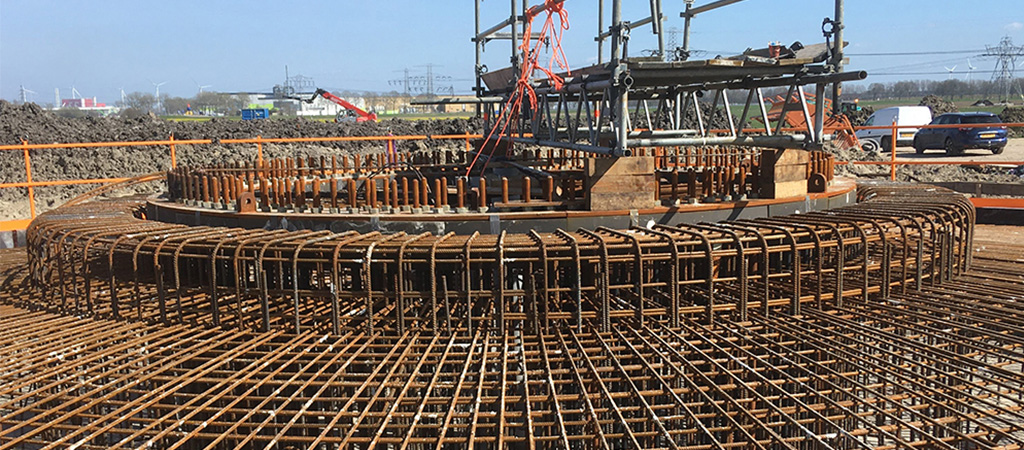
By uncritically accepting preconditions when designing foundations for wind turbines, opportunities for optimization are missed. Windbase offers the opportunity to identify and capitalize on these opportunities with data-driven design.
With data-driven design, many solutions are generated at the front end. This creates a “point cloud” of valid solutions. Valid standard solutions that have already been developed can also be included in this point cloud. By subsequently making design choices (defining boundary conditions), parts of this point cloud will disappear. The effect of design choices on, for example, price and sustainability now becomes immediately visible. By going through this process together with the customer, a suitable solution can be found, and the possible consequences of these choices are immediately clear.
For some customers, “optimal” means the cheapest solution. For others, the most sustainable solution is important. This way, an appropriate criterion can always be used. Other examples of criteria are construction quality, construction speed and safety/manufacturability. For each criterion, a different solution may be the most optimal.
Setting preconditions is in fact imposing restrictions.
Fixed conditions
You would always want to set some preconditions, regardless of the optimization criterion to be used. For instance the turbine loads and the ground conditions. We also always consider standards and regulations as a fixed precondition.
Currently, Windbase has developed the data-driven design method for circular cast-in-situ reinforced concrete shallow and piled foundations.
Parameters
Parameters we can vary in the optimization process.
Variable conditions
It will be interesting when we look at variable preconditions. The restrictions imposed by setting these preconditions translate, for example, into implementation risks that must be mitigated by certain measures. To give you an idea of this, some variable preconditions are described in more detail below as an example.
Slope of top of the base
Choosing a steep slope can result in a saving of concrete. However, with a steep slope, constructability and construction quality may be negatively affected. A steep slope makes finishing the concrete work more difficult. As a mitigating measure, adjustments to the concrete mixture can be considered. In general, more attention is needed on steeper slopes. A steep slope may require measures regarding the accessibility of the turbine if the top of the concrete foundation remains visible.
Backfilling on top of the base
Applying a backfilling on top of the foundation helps create ballast and can therefore result in a smaller foundation diameter and/or savings in concrete work. If the entire foundation is installed below ground level, a ground ballast will always be present. If the foundation is constructed “high”, considering a soil mound becomes interesting. In addition to limiting excavations, the advantage of building at a high level is that the risk of groundwater and groundwater loading is smaller. This therefore results in a simpler design and possibly also a smaller foundation diameter and/or savings in concrete work. A soil mound may also be considered for the appearance of the foundation in the landscape. On the other hand, the finishing of a soil mound requires the necessary extra attention with regards to for instance erosion, tower access and loading capacity.
Stiffness requirements
Normally, in addition to foundation loads, stiffness requirements are also imposed by the turbine manufacturer. These stiffness requirements arise from the dynamic behavior of the tower and foundation. For example, if a certain minimum foundation stiffness is not achieved, our experience is that there is often still some margin in the wind turbine control to allow the turbine to function properly. You can also choose to discuss this with the turbine manufacturer up front. Measures in the tower design may be cheaper than the potential savings in the foundation.
To find an optimal solution of both foundation and tower can also be examined using data driven design. This will require a combined effort from turbine manufacturer and foundation designer.
Foundation diameter
In addition to being an optimization parameter, the foundation diameter is also a (variable) condition. Given the limitations at a location, it may be necessary to limit the foundation diameter. The effect may be that no valid solution can be found in this foundation concept. In that case, other foundation concepts should be investigated.
Windbase has done so for example for the Hartelkanaal Project in Rotterdam, The Netherlands. […]
Pile systems
With a piled foundation, Windbase always includes a number of pile systems in its analysis. It may be that limitations from the surroundings (such as noise and vibrations) mean that certain pile systems cannot be used.
No-gapping criterion
The current guidelines state that the so-called no-gapping criterion can be met with regard to the foundation-soil interaction. For a piled foundation, this means no tension on the pile under S3 load should occur. For a shallow foundation, this means no “gap” (full contact) between foundation and subsoil under S3 load should occur. In many cases this criterion is applied. However, the regulations allow to neglect these requirements under certain conditions. Because in many cases this requires significant additional analysis, this is often not done. However, this is still a design choice in which Windbase can assist.
Wind farm size
For larger wind farms, due to variations in ground conditions, it may be wise to use more site specific designs to achieve an optimal solution. The repetition factor plays a role in this consideration and the limitation of the risk of error during implementation.
Type of analysis method
Windbase BV (formerly ABT BV) is known for its advanced design analyses. Advanced non-linear 3D models are used as a standard. By putting more effort into the analysis, far-reaching material optimizations can be substantiated. A customer is of course always free to opt for a more traditional design approach, which allows for less extensive optimization.